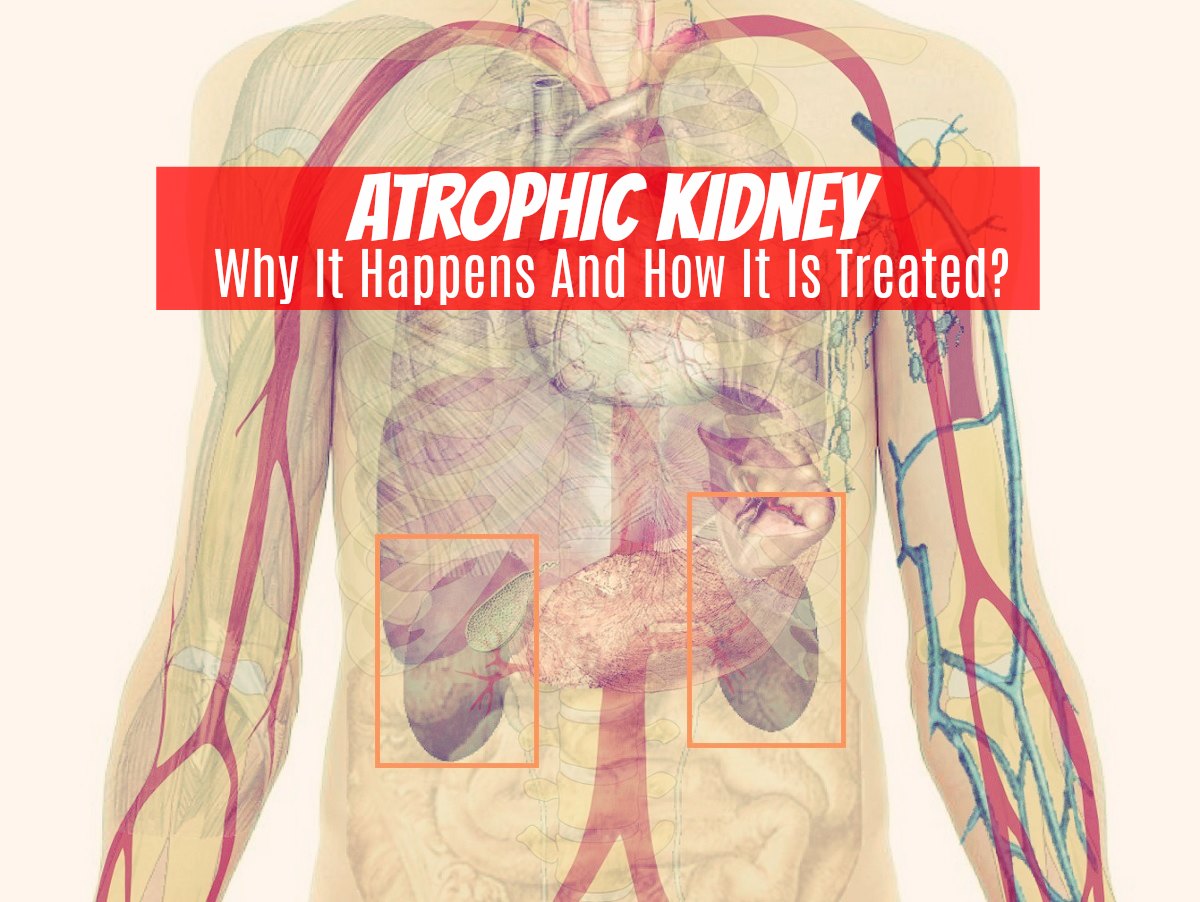The body has two kidneys that are situated in a parallel position just a little below the rib cage.
One kidney is slightly higher than the other to make room for other organs though. The kidneys have several different functions that are vital to a person’s survival, but their main purpose is to filter out impurities and toxins.
So if either of them starts to atrophy because of damage from a disease or infection, then it can make someone very sick.
Because of this, this article will offer in-depth information about the causes of an atrophic kidney and some of the ways that doctors can treat it.
What is an Atrophic Kidney?
According to the Medical Library of Utah, an atrophic kidney is a kidney that has become considerably smaller than it is supposed to be.(1)
Usually, this condition only occurs in one of the kidneys at a time, but on rare occasions, it can happen to both of the kidneys simultaneously.
Those individuals who have been born with a horseshoe-shaped kidney have a higher risk of its occurrence since their kidneys are not separated as they are supposed to be.
But there has to be other factors at play for them to get the condition. Having a horseshoe-shaped kidney alone is not enough to cause a person to develop atrophy in the organ.
Causes
 According to Kidney Healthy, a kidney can start to atrophy for the following reasons:(2)
According to Kidney Healthy, a kidney can start to atrophy for the following reasons:(2)
Infection
The first cause of an atrophic kidney is a bacterial infection in the bladder or urinary tract, which goes untreated for a long period of time. This bacteria spreads to the kidneys and attacks them, so they become weakened.
Diabetes
Diabetes is another risk factor because the condition causes a person to not be able to heal properly. It also increases inflammation in the arteries, damages the nerves, and makes the organs not function properly. And even if a person is doing their best to keep their sugar under control through medications, they may still develop kidney damage as a side effect from them.
Blood Clots
The next way that a kidney can atrophy is if its supply of blood is reduced or cut off. This usually occurs in people who have developed a blood clot in their renal artery. But it can also occur if a person has arteriosclerosis from inflammation and high cholesterol.
Birth Defects
And lastly, there are occasions when someone has an atrophied kidney because of birth defects due to diseases or injuries while they were still in the womb. Of course, this cause of atrophic kidney is seen most often in small children who are still developing.
What are the Symptoms of an Atrophic Kidney?
 According to the National Institute of Health, the symptoms of this type of kidney problem are dependent upon what the main cause of the condition is.(3) If it is due to a bacterial infection, then a person will at first feel like they are getting a bad case of the flu.
According to the National Institute of Health, the symptoms of this type of kidney problem are dependent upon what the main cause of the condition is.(3) If it is due to a bacterial infection, then a person will at first feel like they are getting a bad case of the flu.
A fever will develop, and they might feel a general sense of malaise and weakness.
There will also be a noticeable increase in the amount of urine output as the kidneys attempt to flush the infection out. The worst thing about this symptom is that urination is painful each time because of the way a person has to bear down to push the urine out. The pressure of the muscles against the kidneys is quite unpleasant to say the least.
Sometimes, the damage to the kidney is so severe that internal bleeding will occur. This can be identified by the blood that starts to pass in the urine and the mottled, bruised appearance of the skin over the abdomen.
If blood flow to the kidneys is being restricted from a blood clot or arteriosclerosis, then a person will start to feel pain on the side of the body where the atrophic kidney is located. The pain will gravitate towards the back, so it can easily be confused with a pulled muscle.
Nausea and vomiting will set in shortly thereafter, which causes most people with this condition to struggle with being able to eat more than a few bites of food at a time.
How is This Condition Treated?
The following types of treatments are available:
Antibiotics
In cases of a bacterial infection that has been verified with a blood or urine test, the Mayo Clinic says that a doctor will order a ten-day prescription for antibiotics.(4)
Sometimes, if the infection is severe, a person with the condition will have to be admitted to the hospital to receive the medication intravenously while their urine is taken for testing at regular intervals. This allows a doctor to be able to check their progress and switch medications if need be.
It should be noted that it is rare for ten days of antibiotics to be enough to rid the body of this type of infection. More often than not, a person will have to continue the course of treatment for at least a week or more beyond this. It just depends on how strong their immune system was before the infection occurred.
Blood Clot Removal
Blood clots that are reducing blood flow to the kidneys have to be handled very carefully according to HealthHype because if they dislodge, they could end up heading straight to the heart, lungs, or brain, which could cause a stroke or heart attack.(5)
So a doctor must first identify the exact location of the clot in the renal artery that is restricting the blood flow, then attempt to remove it through surgery. This in itself is dangerous, but there is often no other way to remove the blockage.
Blood-clot filters or blood thinners won’t work fast enough to increase the amount of oxygenated blood and nutrition that the kidney gets, so it will completely shut down.
Dialysis
To test how well the atrophic kidney is functioning, a doctor will check the creatine levels of the body. If they are too high, then dialysis has to be started. Otherwise, toxins will quickly overload the body.
However, dialysis is only done if the kidney still has a chance to be saved. If the blood flow has been blocked for too long, then the kidney could be too far gone.
Surgery
The next course of treatment is surgery. While having two functioning kidneys is ideal, a person can survive with just one. So after the atrophic kidney is removed, Medline Plus says that the body can return to a state of good health again.(6)
However, if for any reason the other kidney becomes atrophied too, then a person will have to be put on an organ donor list. Or they can choose to be hooked up to a dialysis machine for the rest of their life.
When is it Time to See a Doctor?
 If after reading all of this information a person suspects that they may have an atrophic kidney, Web MD says that it is best that they get to a doctor as soon as possible.(7)
If after reading all of this information a person suspects that they may have an atrophic kidney, Web MD says that it is best that they get to a doctor as soon as possible.(7)
This condition can turn deadly very fast if treatment isn’t received. So if the soonest appointment is going to be more than a day or two away, then a trip to the emergency room may be in order, especially if there are symptoms of blood in the urine, pain, and a high fever present.
What do You do if You Develop This Condition?
Besides the treatment options that are mentioned above, the Medical College of Wisconsin says that doctors will usually recommend that a person makes some changes to their diet and lifestyle to help their atrophic kidney heal.(8)
For example, the amount of protein that is consumed has to be reduced significantly because it will stress the kidney too much.
Also, caffeine is irritating to the bladder, urinary tract, and kidneys, so it has to be cut out completely.(9)
That means, no chocolate, coffee, tea, or soda is allowed. Instead, it is best to stick to plain, filtered water and fresh fruits and vegetables as much as possible.
The amount of food that is eaten at a time has to be restricted to just a few spoonfuls. This will make it easier for the body to process. But since most people who have kidney problems don’t have much of an appetite for a while, they don’t usually feel hungry from the food limitation.
Conclusion
In conclusion, an atrophic kidney is a kidney that has shrunk in size because of an infection, damage from diabetes, a blood clot, or congenital defects.
It produces symptoms of pain, frequent urination, blood in the urine, nausea, vomiting, and fever. Since the kidneys are crucial to the removal of toxins in the body, it is very important that anyone who is having any of the symptoms of an atrophic kidney get to the doctor right away.
The longer the kidney is starved of oxygen, the more likely that it will have to be removed with surgery.
Further reading:
References
(1)”library.med.utah.edu/WebPath/RENAHTML/RENAL013.html
(2)”kidneyhealthy.com/tcm/3373.html
(3)”ncbi.nlm.nih.gov/pmc/articles/PMC1532830/
(4)”mayoclinic.org/diseases-conditions/kidney-infection/home/ovc-20342583
(5)”healthhype.com/renal-vein-thrombosis-blood-clot-in-kidney-vein.html
(6)”medlineplus.gov/ency/article/003001.htm
(7)”webmd.com/a-to-z-guides/tc/chronic-kidney-disease-when-to-call-a-doctor
(8)”mcw.edu/Nephrology/Patient-Information/Diet-for-Renal-Patient.htm
(9)”ncbi.nlm.nih.gov/pmc/articles/PMC3036994/
Leave Feedback: Was this article helpful?

